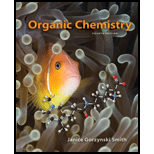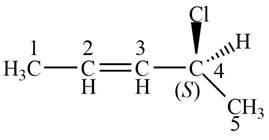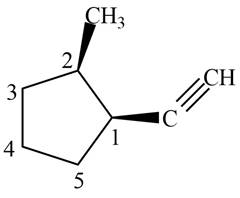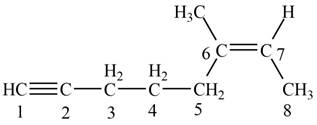
(a)
Interpretation: The structure corresponding to the given name,
Concept introduction: The systematic naming of organic compound is given by IUPAC. The full form of IUPAC is International Union of Pure and Applied Chemistry. The naming of organic compound is done such that the structure of organic compound is correctly interpreted from the name.
Answer to Problem 11.29P
The structure corresponding to the given name,

Explanation of Solution
The structure corresponding to the given name,

Figure 1
This compound contains seven carbon atoms in the longest carbon chain and a triple bond at
The structure corresponding to the given name is shown in Figure 1.
(b)
Interpretation: The structure corresponding to the given name,
Concept introduction: The systematic naming of organic compound is given by IUPAC. The full form of IUPAC is International Union of Pure and Applied Chemistry. The naming of organic compound is done such that the structure of organic compound is correctly interpreted from the name.
Answer to Problem 11.29P
The structure corresponding to the given name,

Explanation of Solution
The structure corresponding to the given name,

Figure 2
This compound contains nine carbon atoms in the longest carbon chain and a triple bond at
The structure corresponding to the given name is shown in Figure 2.
(c)
Interpretation: The structure corresponding to the given name,
Concept introduction: The systematic naming of organic compound is given by IUPAC. The full form of IUPAC is International Union of Pure and Applied Chemistry. The naming of organic compound is done such that the structure of organic compound is correctly interpreted from the name.
Answer to Problem 11.29P
The structure corresponding to the given name,

Explanation of Solution
The structure corresponding to the given name,

Figure 3
This compound contains five carbon atoms in the longest carbon chain and a triple bond at
The structure corresponding to the given name is shown in Figure 3.
(d)
Interpretation: The structure corresponding to the given name,
Concept introduction: The systematic naming of organic compound is given by IUPAC. The full form of IUPAC is International Union of Pure and Applied Chemistry. The naming of organic compound is done such that the structure of organic compound is correctly interpreted from the name.
Answer to Problem 11.29P
The structure corresponding to the given name,

Explanation of Solution
The structure corresponding to the given name,

Figure 4
This compound contains five carbon atoms arranged in a cyclic carbon chain and a triple bond is present outside the cyclic chain. Thus, the five membered cyclic chain of carbon is known to be cyclopentane. One ethynyl group is present at
The structure corresponding to the given name is shown in Figure 4.
(e)
Interpretation: The structure corresponding to the given name,
Concept introduction: The systematic naming of organic compound is given by IUPAC. The full form of IUPAC is International Union of Pure and Applied Chemistry. The naming of organic compound is done such that the structure of organic compound is correctly interpreted from the name.
Answer to Problem 11.29P
The structure corresponding to the given name,

Explanation of Solution
The structure corresponding to the given name,

Figure 5
This compound contains eight carbon atoms arranged in a longest carbon chain and two triple bonds are present at
The structure corresponding to the given name is shown in Figure 5.
(f)
Interpretation: The structure corresponding to the given name,
Concept introduction: The systematic naming of organic compound is given by IUPAC. The full form of IUPAC is International Union of Pure and Applied Chemistry. The naming of organic compound is done such that the structure of organic compound is correctly interpreted from the name.
Answer to Problem 11.29P
The structure corresponding to the given name,

Explanation of Solution
The structure corresponding to the given name,

Figure 6
This compound contains eight carbon atoms arranged in a longest carbon chain, one double bond at
The structure corresponding to the given name is shown in Figure 6.
Want to see more full solutions like this?
Chapter 11 Solutions
Connect Access Card For Organic Chemistry
- What reagent can be used from compound F to G? (NaH / NaOH / LiAlH4+hydronium quench / CrO3 Jones)arrow_forwardUsing chair confirmations, draw the final product of each molecule. Pls explain how are you arrived at the answerthank you!arrow_forwarda.What product(s) (excluding stereoisomers) are formed when Y is heated with Cl2? b.What product(s) (excluding stereoisomers) are formed when Y is heated with Br2? c.What steps are needed to convert Y to the alkene Z?arrow_forward
- (a) What product(s) are formed when the E isomer of C6H5CH = CHC6H5 is treated with Br2, followed by one equivalent of KOH? Label the resulting alkene(s) as E or Z. (b) What product(s) are formed when the Z isomer of C6H5CH = CHC6H5 is subjected to the same reaction sequence? (c) How are the compounds in parts (a) and (b) related to each other?arrow_forwardreagents x and y are?arrow_forward(a) Draw all constitutional isomers formed by monochlorination of each alkane with Cl2 and hν. (b) Draw the major monobromination product formed by heating each alkane with Br2.arrow_forward
- Rank the following alkenes from least to most stable. Then explain why you picked this order.arrow_forwardThese reagents can produce ketones with alkynes A. BH3, THF, H2O2 B. KMnO4 C. O3 D. H2SO4, H2O, HgSO4 choices:A,DB,CA,B,CA,B,C,Darrow_forwardWhat alkane is needed to make each alkyl halide by radical halogenation?arrow_forward
 Organic Chemistry: A Guided InquiryChemistryISBN:9780618974122Author:Andrei StraumanisPublisher:Cengage Learning
Organic Chemistry: A Guided InquiryChemistryISBN:9780618974122Author:Andrei StraumanisPublisher:Cengage Learning

